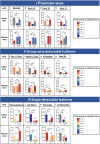Full-length transcriptomic analysis in murine and human heart reveals diversity of PGC-1α promoters and isoforms regulated distinctly in myocardial ischemia and obesity
- PMID: 35907957
- PMCID: PMC9338484
- DOI: 10.1186/s12915-022-01360-w
Full-length transcriptomic analysis in murine and human heart reveals diversity of PGC-1α promoters and isoforms regulated distinctly in myocardial ischemia and obesity
Abstract
Background: Peroxisome proliferator-activated receptor gamma coactivator-1 alpha (PGC-1α) acts as a transcriptional coactivator and regulates mitochondrial function. Various isoforms are generated by alternative splicing and differentially regulated promoters. In the heart, total PGC-1α deficiency knockout leads to dilatative cardiomyopathy, but knowledge on the complexity of cardiac isoform expression of PGC-1α remains sparse. Thus, this study aims to generate a reliable dataset on cardiac isoform expression pattern by long-read mRNA sequencing, followed by investigation of differential regulation of PGC-1α isoforms under metabolic and ischemic stress, using high-fat-high-sucrose-diet-induced obesity and a murine model of myocardial infarction.
Results: Murine (C57Bl/6J) or human heart tissue (obtained during LVAD-surgery) was used for long-read mRNA sequencing, resulting in full-length transcriptomes including 58,000 mRNA isoforms with 99% sequence accuracy. Automatic bioinformatic analysis as well as manual similarity search against exonic sequences leads to identification of putative coding PGC-1α isoforms, validated by PCR and Sanger sequencing. Thereby, 12 novel transcripts generated by hitherto unknown splicing events were detected. In addition, we postulate a novel promoter with homologous and strongly conserved sequence in human heart. High-fat diet as well as ischemia/reperfusion (I/R) injury transiently reduced cardiac expression of PGC-1α isoforms, with the most pronounced effect in the infarcted area. Recovery of PGC-1α-isoform expression was even more decelerated when I/R was performed in diet-induced obese mice.
Conclusions: We deciphered for the first time a complete full-length transcriptome of the murine and human heart, identifying novel putative PGC-1α coding transcripts including a novel promoter. These transcripts are differentially regulated in I/R and obesity suggesting transcriptional regulation and alternative splicing that may modulate PGC-1α function in the injured and metabolically challenged heart.
Keywords: Diet-induced obesity; Ischemia/reperfusion; Long-read sequencing; PGC-1α.
© 2022. The Author(s).
Conflict of interest statement
The authors declare that they have no competing interests.
Figures







Similar articles
-
Peroxisome Proliferator-activated Receptor γ Coactivator-1 α Isoforms Selectively Regulate Multiple Splicing Events on Target Genes.J Biol Chem. 2016 Jul 15;291(29):15169-84. doi: 10.1074/jbc.M115.705822. Epub 2016 May 26. J Biol Chem. 2016. PMID: 27231350 Free PMC article.
-
An unexpected role for the transcriptional coactivator isoform NT-PGC-1α in the regulation of mitochondrial respiration in brown adipocytes.J Biol Chem. 2017 Jun 16;292(24):9958-9966. doi: 10.1074/jbc.M117.778373. Epub 2017 May 4. J Biol Chem. 2017. PMID: 28473468 Free PMC article.
-
Isoform-specific increases in murine skeletal muscle peroxisome proliferator-activated receptor-gamma coactivator-1alpha (PGC-1alpha) mRNA in response to beta2-adrenergic receptor activation and exercise.Endocrinology. 2008 Sep;149(9):4527-33. doi: 10.1210/en.2008-0466. Epub 2008 May 29. Endocrinology. 2008. PMID: 18511502
-
The hitchhiker's guide to PGC-1α isoform structure and biological functions.Diabetologia. 2015 Sep;58(9):1969-77. doi: 10.1007/s00125-015-3671-z. Epub 2015 Jun 25. Diabetologia. 2015. PMID: 26109214 Review.
-
PGC-1α, Inflammation, and Oxidative Stress: An Integrative View in Metabolism.Oxid Med Cell Longev. 2020 Mar 9;2020:1452696. doi: 10.1155/2020/1452696. eCollection 2020. Oxid Med Cell Longev. 2020. PMID: 32215168 Free PMC article. Review.
Cited by
-
Peroxisome proliferator‑activated receptor γ coactivator‑1α in heart disease (Review).Mol Med Rep. 2025 Jan;31(1):17. doi: 10.3892/mmr.2024.13382. Epub 2024 Nov 8. Mol Med Rep. 2025. PMID: 39513608 Free PMC article. Review.
-
Notable challenges posed by long-read sequencing for the study of transcriptional diversity and genome annotation.Genome Res. 2025 Apr 14;35(4):583-592. doi: 10.1101/gr.279865.124. Genome Res. 2025. PMID: 40032585 Free PMC article. Review.
-
Mitochondrial quality control in human health and disease.Mil Med Res. 2024 May 29;11(1):32. doi: 10.1186/s40779-024-00536-5. Mil Med Res. 2024. PMID: 38812059 Free PMC article. Review.
-
Mechanistic Insights into Alternative Gene Splicing in Oxidative Stress and Tissue Injury.Antioxid Redox Signal. 2024 Nov;41(13-15):890-909. doi: 10.1089/ars.2023.0437. Epub 2023 Nov 23. Antioxid Redox Signal. 2024. PMID: 37776178 Review.
-
The Anti-Obesity Effect of Fish Oil in Diet-Induced Obese Mice Occurs via Both Decreased Food Intake and the Induction of Heat Production Genes in Brown but Not White Adipose Tissue.Int J Mol Sci. 2024 Dec 31;26(1):302. doi: 10.3390/ijms26010302. Int J Mol Sci. 2024. PMID: 39796158 Free PMC article.
References
-
- Martínez-Redondo V, Jannig PR, Correia JC, Ferreira DM, Cervenka I, Lindvall JM, et al. Peroxisome proliferator-activated receptor γ coactivator-1 α isoforms selectively regulate multiple splicing events on target genes. J Biol Chem. 2016;291(29):15169–15184. doi: 10.1074/jbc.M115.705822. - DOI - PMC - PubMed
Publication types
MeSH terms
Substances
LinkOut - more resources
Full Text Sources

